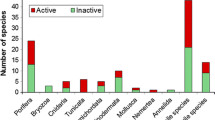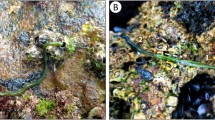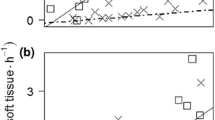Abstract
Marine hydroids are commonly thought to be defended by stinging organelles called nematocysts that penetrate predator tissues and inject proteinaceous venoms, but not all hydroids possess these nematocysts. Although an increasing number of bioactive secondary metabolites have been isolated from marine hydroids, ecological roles of these compounds are poorly known. To test the hypothesis that nematocysts and noxious secondary metabolites represent alternative defenses against predation, we examined hydroids from North Carolina, United States for: (1) the palatability of whole polyps before and after nematocysts had been deactivated; (2) the palatability of their chemical extracts; and (3) their nutritional value in terms of organic content, protein content, and levels of refractory structural material (chitin). All hydroids were avoided by a generalist predator, the pinfish Lagodon rhomboides, compared with palatable control foods. Two of these (Halocordyle disticha and Tubularia crocea) became palatable after being treated with potassium chloride to discharge their nematocysts, suggesting that these species rely on nematocysts for defenses against predators. Chemical extracts from nematocyst-defended species had no effect on fish feeding. The four species that remained unpalatable after nematocysts had been discharged (Corydendrium parasiticum, Eudendrium carneum, Hydractinia symbiolongicarpus, Tridentata marginata) possessed chemical extracts that deterred feeding by pinfish. We have isolated and characterized the structures of the deterrent metabolites in two of these species. We found no differences in nutritional content or levels of chitin between nematocyst-defended and chemically defended species, and no evidence that either of these played a role in the rejection of hydroids as prey. Our results suggest that, among hydroids, chemical defenses may be at least as common as nematocyst-based defenses and that the two may represent largely alternative defensive strategies. The four hydroid species with deterrent extracts represent four families and both sub-orders of hydroids, suggesting that chemical defenses in this group may be widespread and have multiple origins.
Similar content being viewed by others
Author information
Authors and Affiliations
Additional information
Received: 25 May 1999 / Accepted: 1 February 2000
Rights and permissions
About this article
Cite this article
Stachowicz, J., Lindquist, N. Hydroid defenses against predators: the importance of secondary metabolites versus nematocysts. Oecologia 124, 280–288 (2000). https://doi.org/10.1007/s004420000372
Issue Date:
DOI: https://doi.org/10.1007/s004420000372




